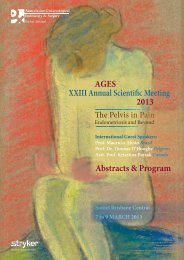to Obstetric Trauma Pelvic Floor Repair Surgical Essentials - AGES
to Obstetric Trauma Pelvic Floor Repair Surgical Essentials - AGES
to Obstetric Trauma Pelvic Floor Repair Surgical Essentials - AGES
Create successful ePaper yourself
Turn your PDF publications into a flip-book with our unique Google optimized e-Paper software.
<strong>AGES</strong><br />
<strong>Pelvic</strong> <strong>Floor</strong><br />
Symposium &<br />
Workshop XII<br />
2011<br />
<strong>to</strong><br />
<strong>Obstetric</strong> <strong>Trauma</strong><br />
<strong>Pelvic</strong> <strong>Floor</strong> <strong>Repair</strong><br />
<strong>Surgical</strong> <strong>Essentials</strong><br />
8<br />
apical resuspension & treatment of coexisting anterior and posterior<br />
compartment defects.<br />
REFERENCE:<br />
1. Vanspauwen R, Seman E, Dwyer P. Survey of current<br />
management of prolapse in Australia & New Zealand. ANZJOG<br />
2010; 50: 262-267<br />
AUTHOR AFFILIATION: Elvis Seman and Nick Bedford; Department<br />
of <strong>Obstetric</strong>s, Gynaecology and Reproductive Medicine, Flinders<br />
Medical Centre, South Australia, Australia.<br />
Session 3 / 1410-1430<br />
Vaginal uterosacral / sacrospinous<br />
hysteropexy<br />
Lotze P<br />
OBJECTIVES: A hysterec<strong>to</strong>my has long remained a standard<br />
component of pelvic reconstructive surgery. However, for<br />
those patients who want <strong>to</strong> maintain their fertility, the need<br />
for a hysterec<strong>to</strong>my is increasingly questioned. The goal of this<br />
presentation is <strong>to</strong> examine the differing viewpoints of maintaining<br />
versus removing the uterus. Techniques for performing a<br />
transvaginal suture repair and the available literature on success<br />
rates will be reviewed.<br />
METHODS: A literature review of the transvaginal uterosacral ligament<br />
suspension and sacrospinous hysteropexy will be described. Emphasis<br />
is placed on surgical techniques that do not involve mesh /graft<br />
implant as a component of the suspension technique.<br />
RESULTS: To date, there is very limited data on the transvaginal<br />
uterosacral suspension with some authors reporting success<br />
rates of ~85%. This paucity of data may be in part due <strong>to</strong> the<br />
limited performance of this challenging approach. The sacropinous<br />
hysteropexy has success rates of 89% - 93%. These success rates<br />
are similar <strong>to</strong> those reported for abdominal suspension procedures<br />
such as the sacrohysteropexy. Assessments of functional outcomes<br />
show few operative complications, a shorter return <strong>to</strong> work, and<br />
lower risk of subsequent irritative bladder symp<strong>to</strong>ms.<br />
CONCLUSIONS: <strong>Surgical</strong> approaches <strong>to</strong> uterine-sparing surgery<br />
are becoming more commonplace. Although outcome data for<br />
the transvaginal uterosacral ligament suspension remains sparse,<br />
the data on the vaginal hysteropexy is broad. Studies <strong>to</strong> date<br />
have demonstrated acceptable cure rates. Functional outcomes,<br />
when compared <strong>to</strong> patients undergoing a hysterec<strong>to</strong>my, tend <strong>to</strong><br />
favour uterine-sparing procedures. Still, studies have been limited<br />
by lack of selection bias and well-developed randomized control<br />
trials. Despite this, sacrospinous hysteropexy remains a viable<br />
consideration for patients with apical prolapse who desire uterine<br />
preservation.<br />
RECOMMENDED READING:<br />
1. Zucchi A, et al. (2010) Uterus preservation in pelvic organ<br />
prolapse. Nat Rev Urol. 7:626-633.<br />
AUTHOR AFFILIATION: Peter Lotze, MD, FACOG; Fellowship<br />
Direc<strong>to</strong>r, Urogynecology and <strong>Pelvic</strong> Reconstructive Surgery Women’s<br />
<strong>Pelvic</strong> Health & Continence Center Clinical Assistant Professor,<br />
Division of Urogynecology, Dept of OB/Gyn UTHSC-Hous<strong>to</strong>n; Baylor<br />
College of Medicine Hous<strong>to</strong>n, Texas, USA.<br />
Session 3 / 1440-1500<br />
Manchester <strong>Repair</strong> revisited:<br />
obsolescence or a uterine sparing<br />
alternative <br />
McEvoy M<br />
Initially Archibald Donald, working in the heavily industrialized area of<br />
Manchester with a high parity female cot<strong>to</strong>n mill workforce, developed<br />
the Manchester repair in 1888 after many failures with standard<br />
repair. He claims that the first series of repairs were 97% successful!<br />
Dr William Fothergill, a junior colleague, made several modifications<br />
<strong>to</strong> the procedure and wrote it up in journals. It was subsequently<br />
eponymously known as the Donald–Fothergill Operation and later<br />
the Manchester operation. A detailed account of the procedure will<br />
be given: essentially it involves amputation of the cervix, plication of<br />
the cardinal ligaments anteriorly in<strong>to</strong> the supracervical ring, and a<br />
posterior Sturmdorf suture plicating the uterosacrals posteriorly. No<br />
entry <strong>to</strong> the peri<strong>to</strong>neal cavity made it a safer anaesthetic procedure<br />
than for vaginal hysterec<strong>to</strong>my<br />
Contemporary indications for Manchester repair may include<br />
prolapse in which uterine preservation or future fertility is desired, or<br />
in the situation of severe cervical elongation. It is hard <strong>to</strong> determine<br />
from the literature what obstetric outcomes are expected after<br />
Manchester, although anecdotally prematurity is common.<br />
Today preservation of the uterus is less frequently requested,<br />
although a request for avoidance of mesh use is frequent in our<br />
highly educated population of women. These days there are<br />
very good abdominal, laparoscopic and vaginal vault suspending

















